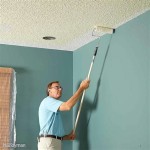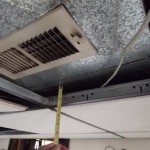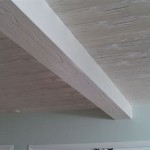How To Remove Stains From Drop Ceiling Tiles
Drop ceiling tiles, also known as suspended ceiling tiles, are a common feature in commercial buildings, basements, and even some homes. They provide a relatively inexpensive and easy-to-install solution for concealing ductwork, piping, and wiring. However, these tiles are often porous and susceptible to staining from various sources such as water leaks, smoke, grease, and mold. Maintaining the cleanliness and appearance of drop ceiling tiles is important for both aesthetic and hygienic reasons. This article provides a comprehensive guide on how to effectively remove different types of stains from drop ceiling tiles.
Before attempting to clean any drop ceiling tile, it is crucial to identify the type of stain and the material of the tile. Different tiles are made from various materials, including mineral fiber, fiberglass, and gypsum, each reacting differently to cleaning agents. Applying the wrong cleaning method can potentially damage the tile, making the stain worse or even requiring replacement of the tile. Similarly, the nature of the stain dictates the appropriate cleaning solution and technique to use.
Furthermore, safety precautions must be taken before commencing the cleaning process. Working overhead always carries the risk of falling debris or cleaning solutions. Wear safety glasses to protect the eyes from falling dust and cleaning splashes. Consider wearing a dust mask or respirator, particularly if dealing with mold or mildew. Protect the floor below the work area with drop cloths or plastic sheeting to prevent drips and spills from damaging the flooring.
Identifying The Stain and Tile Material
The first step in effectively removing stains from drop ceiling tiles is accurately identifying the nature of the stain. Common types of stains include water stains, which often appear as circular or irregularly shaped discoloration; smoke stains, which tend to be a uniform gray or brown; grease stains, typically found in areas near kitchens or food preparation areas; and mold or mildew stains, which are usually greenish, black, or brown in color. Each type of stain requires a different approach to removal.
Water stains are typically caused by leaks from plumbing, roofing, or HVAC systems. These stains can be relatively easy to remove if addressed promptly. However, if the leak is ongoing, the stain will reappear, and the underlying issue causing the leak must be resolved before attempting to clean the tile. Smoke stains are more difficult to remove due to the fine particles of soot and other combustion byproducts that penetrate the porous surface of the tile. Grease stains are often sticky and can attract more dirt over time, making them increasingly challenging to remove. Mold and mildew stains pose a health hazard and require special handling to prevent the spread of spores.
Identifying the tile material is equally important. Mineral fiber tiles are the most common type and are generally porous and absorbent. Fiberglass tiles are more resistant to moisture and staining due to their smoother surface. Gypsum tiles are less common but are more durable and resistant to staining than mineral fiber tiles. The tile material can often be identified by visually inspecting the tile's surface and edges. Mineral fiber tiles typically have a textured or rough surface, while fiberglass tiles have a smoother, woven appearance. Gypsum tiles tend to be denser and heavier than the other types.
If uncertain about the tile material, it is advisable to consult the manufacturer's specifications or test a small, inconspicuous area of the tile with a mild cleaning solution before proceeding with the entire cleaning process. This test will help determine the tile's reaction to the cleaning solution and prevent potential damage.
Cleaning Methods for Different Stain Types
Once the stain and tile material have been identified, the appropriate cleaning method can be selected. Various methods are available, ranging from dry cleaning techniques to the use of cleaning solutions. The chosen method should be effective in removing the stain without damaging the tile.
Dry Cleaning Methods: Dry cleaning methods are generally the safest option for cleaning drop ceiling tiles, particularly those made from mineral fiber. These methods minimize the risk of water damage or discoloration. One common dry cleaning method involves using a dry sponge or a chemical sponge specifically designed for cleaning delicate surfaces. These sponges are made from a porous material that absorbs dirt and grime without requiring water. Gently rub the sponge over the stained area, using light pressure and overlapping strokes. Avoid excessive scrubbing, which can damage the tile's surface. Regularly clean or replace the sponge as it becomes saturated with dirt.
Another dry cleaning method involves using a vacuum cleaner with a brush attachment. Carefully vacuum the stained area, using a low suction setting to avoid damaging the tile. The brush attachment helps to loosen dirt and debris, which are then vacuumed away. This method is particularly effective for removing loose dust and dirt. However, it may not be sufficient for removing deeply embedded stains.
Wet Cleaning Methods: Wet cleaning methods involve the use of cleaning solutions to dissolve and remove stains. These methods should be used with caution, particularly on mineral fiber tiles, as excessive moisture can cause the tile to sag or become discolored. Always test the cleaning solution on a small, inconspicuous area of the tile before applying it to the entire stained area.
For water stains, a mild solution of warm water and dish soap can be effective. Mix a small amount of dish soap with warm water in a spray bottle. Lightly spray the stained area, being careful not to saturate the tile. Gently blot the area with a clean, damp cloth. Avoid rubbing, which can spread the stain. Repeat the process as necessary until the stain is removed. Allow the tile to air dry completely.
For smoke stains, a stronger cleaning solution may be required. A mixture of water and white vinegar can be effective in removing smoke stains. Mix equal parts of water and white vinegar in a spray bottle. Lightly spray the stained area and let it sit for a few minutes. Gently blot the area with a clean, damp cloth. Repeat the process as necessary. Vinegar has a distinctive odor, so ensure adequate ventilation during and after the cleaning process. A solution of trisodium phosphate (TSP) can also be used for removing smoke stains, but TSP is a strong cleaning agent and should be used with caution. Always wear gloves and eye protection when using TSP, and follow the manufacturer's instructions carefully.
For grease stains, a degreasing cleaner may be necessary. Apply the degreasing cleaner to the stained area according to the manufacturer's instructions. Let it sit for a few minutes to dissolve the grease. Gently blot the area with a clean, damp cloth. Repeat the process as necessary. Ensure that the degreasing cleaner is compatible with the tile material to avoid damage.
For mold and mildew stains, a solution of bleach and water can be used. Mix one part bleach with ten parts water in a spray bottle. Lightly spray the stained area and let it sit for a few minutes. Gently blot the area with a clean, damp cloth. Repeat the process as necessary. Bleach can discolor some materials, so always test the solution on a small, inconspicuous area of the tile before applying it to the entire stained area. Wear gloves and eye protection when using bleach, and ensure adequate ventilation.
Specialized Cleaning Products: In addition to homemade cleaning solutions, several specialized cleaning products are available for removing stains from drop ceiling tiles. These products are often formulated to be effective on specific types of stains and tile materials. Always follow the manufacturer's instructions carefully when using specialized cleaning products.
Preventative Measures and Maintenance
Preventing stains from occurring in the first place is the best way to maintain the appearance of drop ceiling tiles. Regular maintenance and preventative measures can significantly reduce the likelihood of staining and the need for extensive cleaning.
Regular Inspections: Regularly inspect the drop ceiling tiles for signs of water leaks, mold growth, or other potential problems. Addressing these issues promptly can prevent them from causing permanent stains. Pay particular attention to areas near plumbing fixtures, roofing penetrations, and HVAC equipment.
Ventilation: Ensure adequate ventilation in areas prone to moisture, such as bathrooms and kitchens. Proper ventilation helps to prevent the growth of mold and mildew. Use exhaust fans when showering or cooking, and consider installing dehumidifiers in damp basements.
Prompt Spill Cleanup: Clean up any spills or drips immediately to prevent them from staining the tiles. Use a clean, absorbent cloth to blot the spill, working from the outside edge inward to prevent spreading. Avoid rubbing, which can push the stain deeper into the tile.
Dusting: Regularly dust the drop ceiling tiles to remove loose dirt and debris. Use a soft brush attachment on a vacuum cleaner or a dry mop to gently dust the tiles. This helps to prevent dirt from accumulating and becoming embedded in the tile's surface.
Replace Damaged Tiles: Replace any damaged or heavily stained tiles immediately. This not only improves the appearance of the ceiling but also prevents potential health hazards, such as mold growth. Replacement tiles are typically readily available from home improvement stores.
By following these preventative measures and promptly addressing any issues that arise, the need for extensive cleaning can be minimized, and the appearance of drop ceiling tiles can be maintained for years to come.
In summary, effective stain removal from drop ceiling tiles requires careful identification of the stain and tile material, selection of the appropriate cleaning method, and adherence to safety precautions. By combining these techniques with regular maintenance and preventative measures, the lifespan and aesthetic appeal of drop ceiling tiles can be greatly extended.

How To Remove Ceiling Water Stains From White Tiles Mp4

How To Remove Water Stains From Ceiling Tile Perfect Results

How To Remove Stains From Ceiling Tiles Curbly

How To Remove Water Stains From Ceiling Tiles Gainey Ceramics

Ceiling Tile Stains Disappear With This Trick

Best Way To Remove Water Stain On Dropped Ceiling Tile Hometalk

Looking Up Why Keeping Ceiling Tiles Clean Matters The Abbey Cleaning Service

How To Remove Water Spots On The Ceiling Brodi Specialty S Ltd

5 Helpful Tips To Clean Your Suspended Ceiling Tiles
How To Repair Damaged Suspended Ceiling Step By Guide
Related Posts








